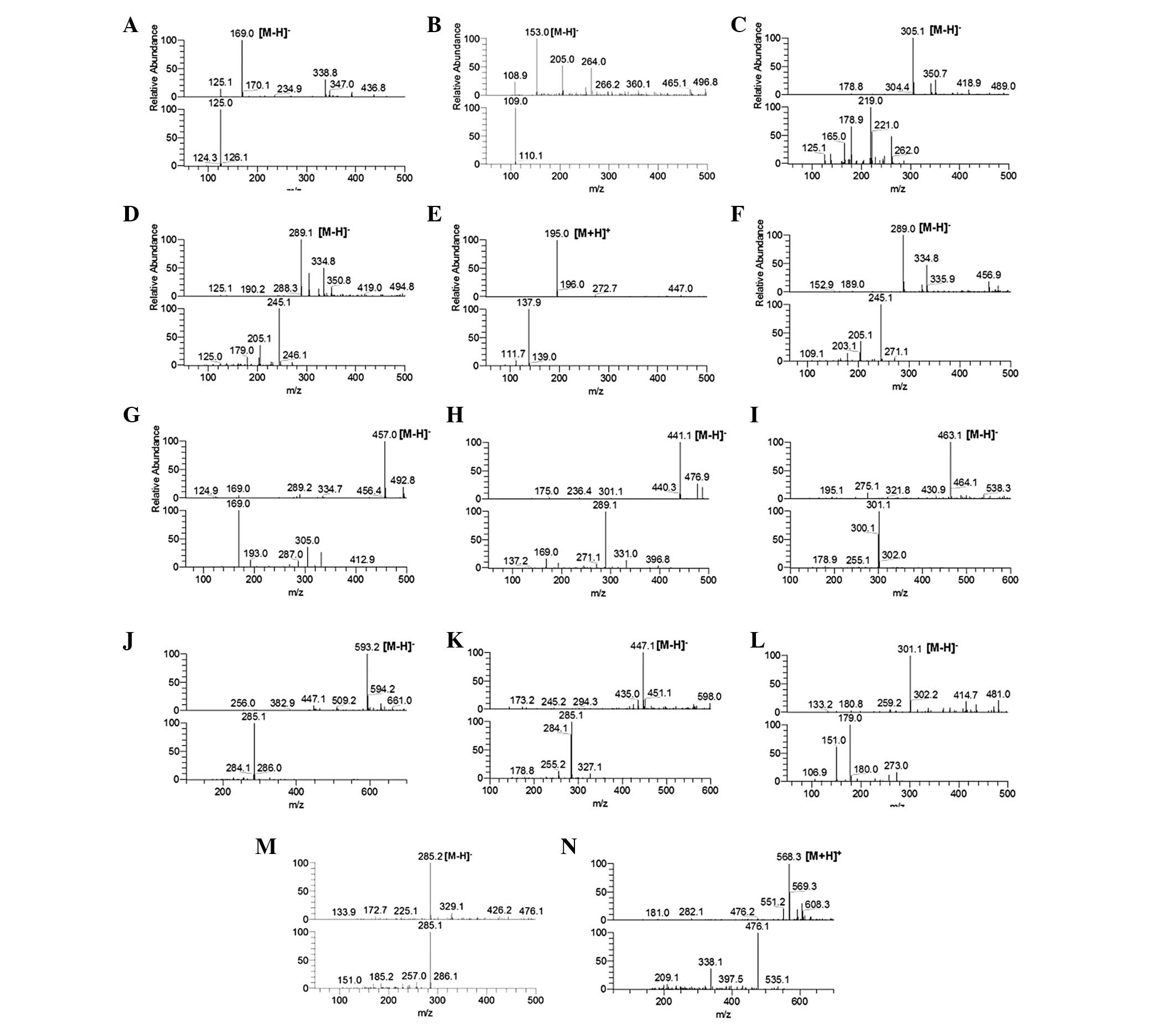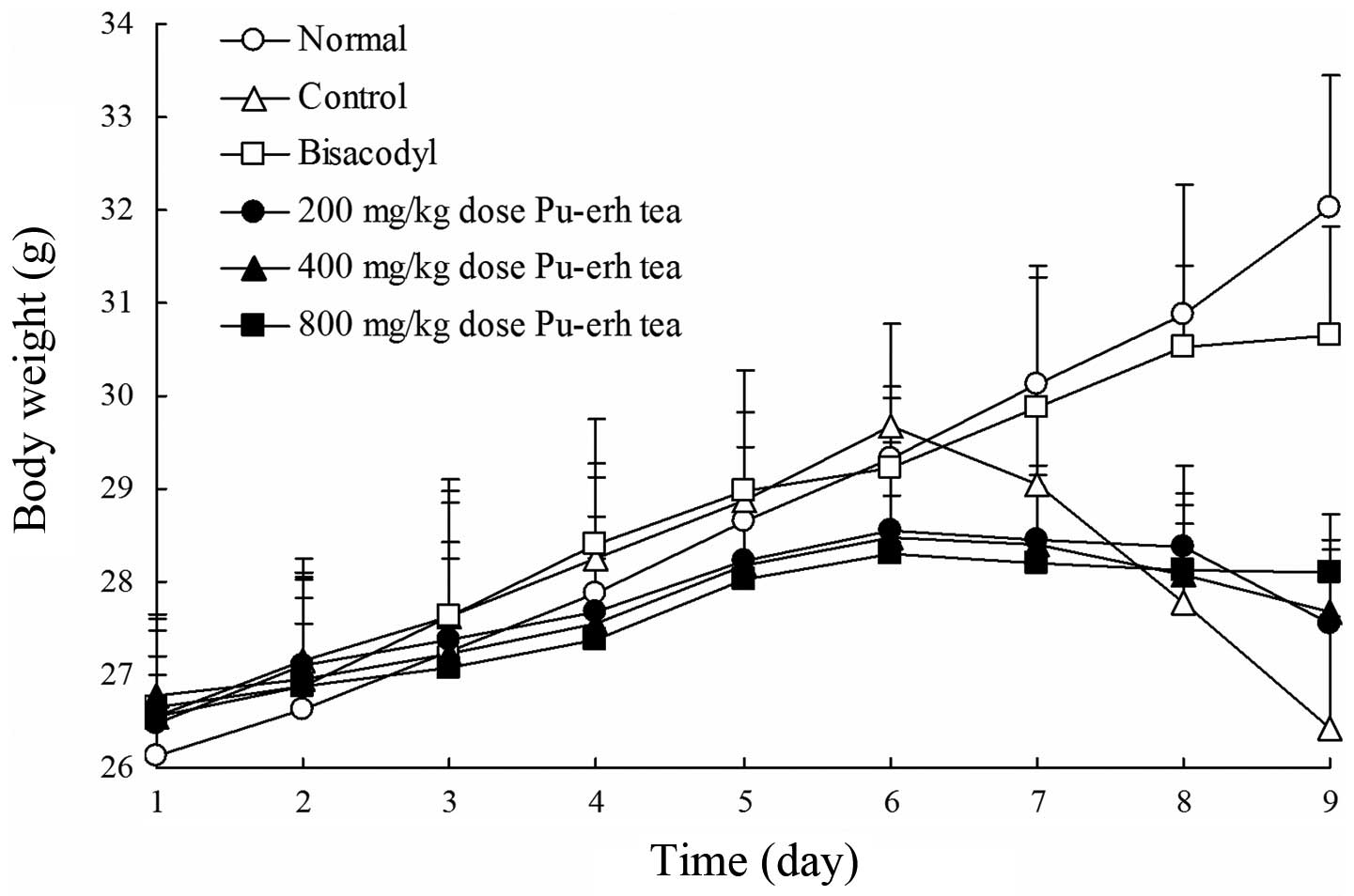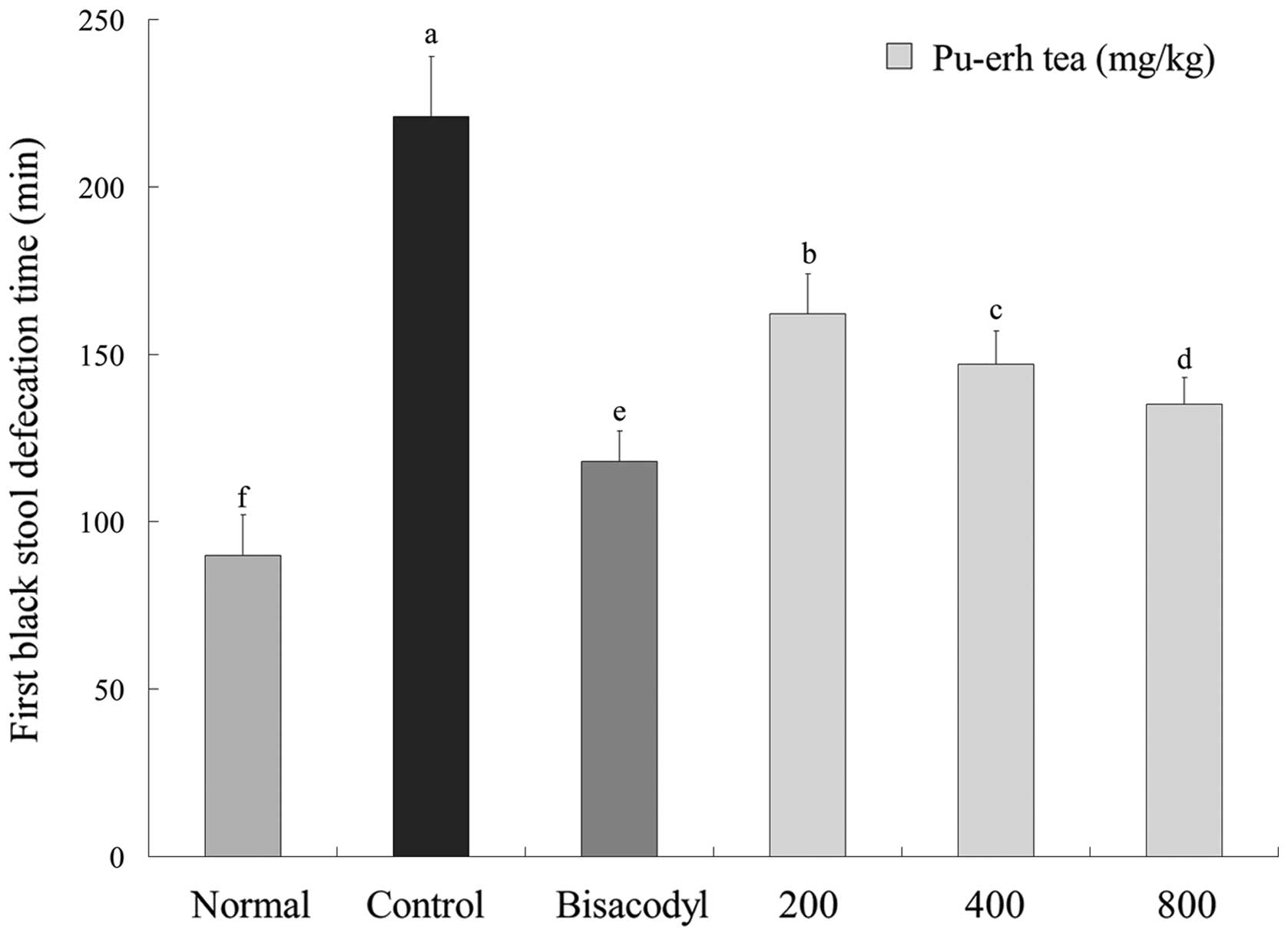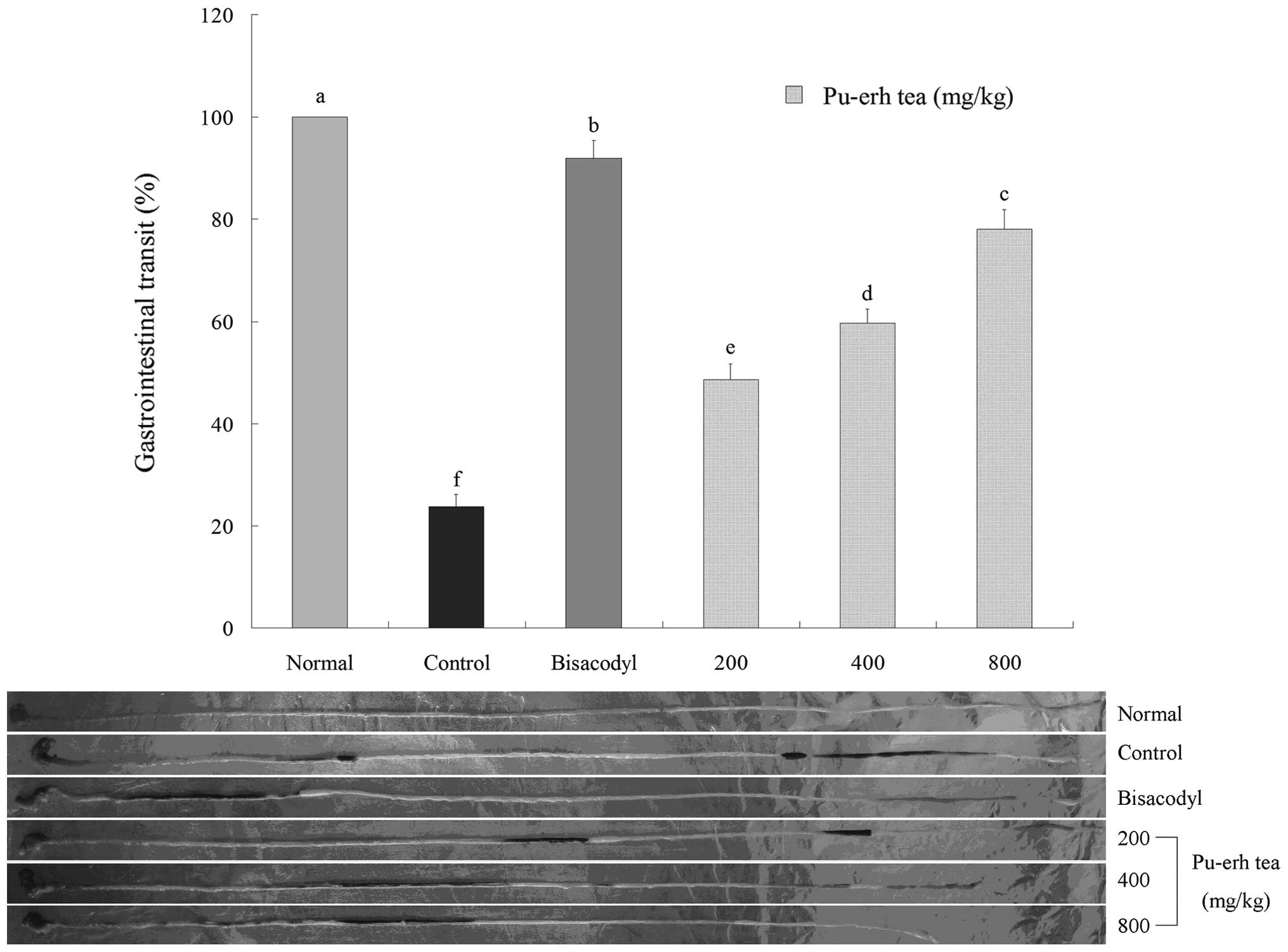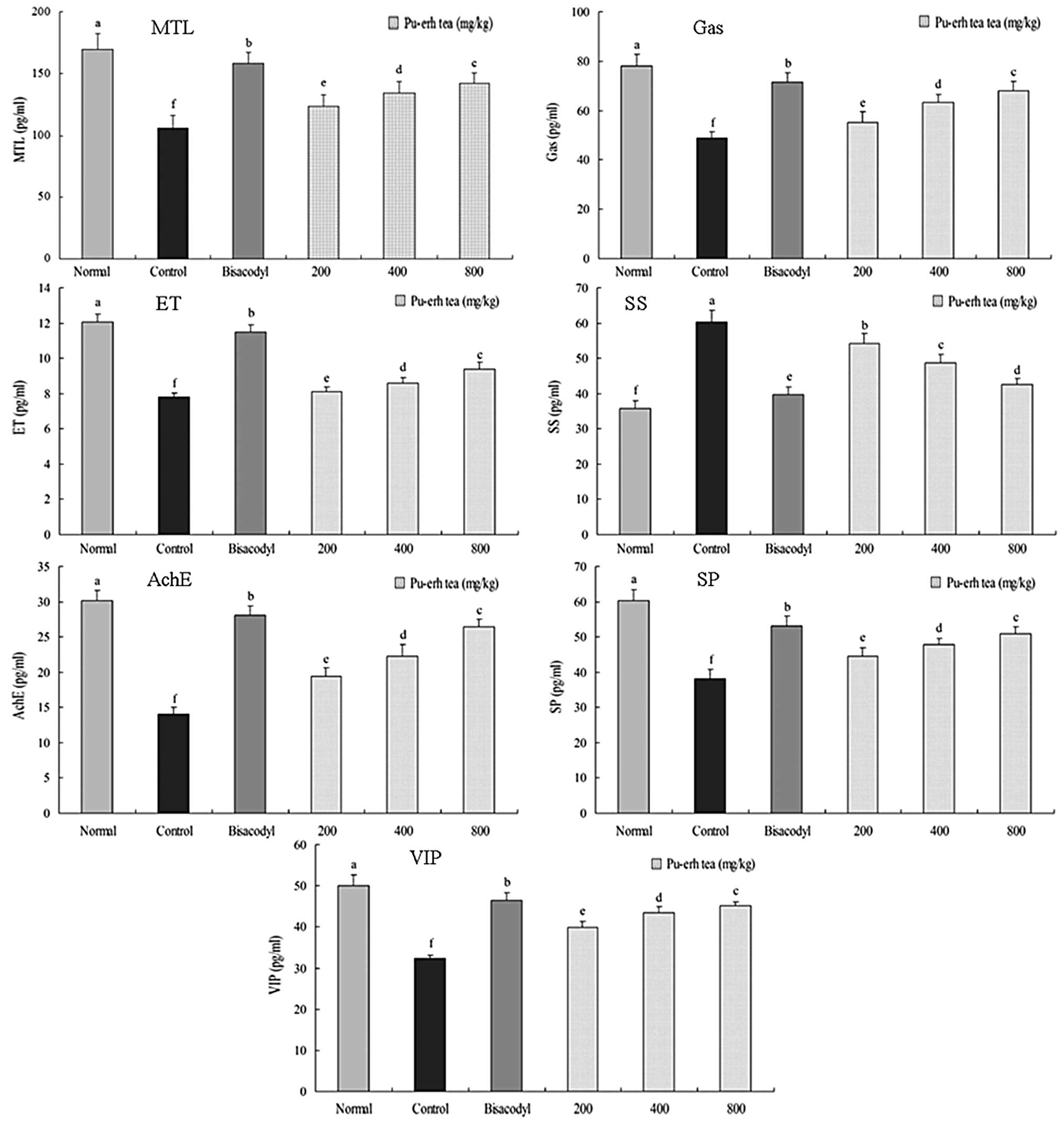|
1
|
Weisburger JH: Tea and health: the
underlying mechanisms. Proc Soc Exp Biol Med. 220:271–275. 1999.
View Article : Google Scholar : PubMed/NCBI
|
|
2
|
Gong ZQ, Watanabe N, Yagi A, Etoh H,
Sakata K, Ina K and Liu QJ: Compositional change of Pu-erh tea
during processing. Biosci Biotechnol Biochem. 57:1745–1746. 1993.
View Article : Google Scholar
|
|
3
|
Duh PD, Yen GC, Yen WJ, Wang BS and Chang
LW: Effects of pu-erh tea on oxidative damage and nitric oxide
scavenging. J Agric Food Chem. 52:8169–8176. 2004. View Article : Google Scholar : PubMed/NCBI
|
|
4
|
Ueki A and Otsuka M: Life style risks of
Parkinson’s disease: Association between decreased water intake and
constipation. J Neurol. 251:18–23. 2004.
|
|
5
|
Wexner SD, Beck DE, Baron TH, Fanelli RD,
Hyman N, Shen B and Wasco KE: A consensus document on bowel
preparation before colonoscopy: prepared by a task force from the
American society of colon and rectal surgeons (ASCRS), the American
society for gastrointestinal endoscopy (ASGE), and the society of
American gastrointestinal and endoscopic surgeons (SAGES). Dis
Colon Rectum. 49:792–809. 2006.
|
|
6
|
Farrugia G, Miller SM, Rich A, Liu X,
Maines MD, Rae JL and Szurszewski JH: Distribution of heme
oxygenase and effects of exogenous carbon monoxide in canine
jejunum. Am J Physiol. 274:G350–G358. 1998.PubMed/NCBI
|
|
7
|
Farrugia G, Lei S, Lin X, Miller SM, Nath
KA, Ferris CD, Levitt M and Szurszewski JH: A major role for carbon
monoxide as an endogenous hyperpolarizing factor in the
gastrointestinal tract. Proc Natl Acad Sci USA. 100:8567–8570.
2003. View Article : Google Scholar : PubMed/NCBI
|
|
8
|
Miller SM, Reed D, Sarr MG, Farrugia G and
Szurszewski JH: Haem oxygenase in enteric nervous system of human
stomach and jejunum and co-localization with nitric oxide synthase.
Neurogastroenterol Motil. 13:121–131. 2001. View Article : Google Scholar : PubMed/NCBI
|
|
9
|
Xue L, Farrugia G, Miller SM, Ferris CD,
Snyder SH and Szurszewski JH: Carbon monoxide and nitric oxide as
coneurotransmitters in the enteric nervous system: evidence from
genomic deletion of biosynthetic enzymes. Proc Natl Acad Sci USA.
97:1851–1855. 2000. View Article : Google Scholar : PubMed/NCBI
|
|
10
|
Lee JS, Kim DH, Liu KH, Oh TK and Lee CH:
Identification of flavonoids using liquid chromatography with
electrospray ionization and ion trap tandem mass spectrometry with
an MS/MS library. Rapid Commun Mass Spectrom. 19:3539–3548. 2005.
View Article : Google Scholar : PubMed/NCBI
|
|
11
|
Wu SC, Yen GC, Wang BS, Chiu CK, Yen WJ,
Chang LW and Du PD: Antimutagenic and antimicrobial activities of
pu-erh tea. LWT-Food Sci Technol. 40:506–512. 2007. View Article : Google Scholar
|
|
12
|
Chrubasik C, Maier T, Dawid C, Torda T,
Schieber A, Hofmann T and Chrubasik S: An observational study and
quantification of the actives in a supplement with Sambucus
nigra and Asparagus officinalis used for weight
reduction. Phytother Res. 22:913–918. 2008. View Article : Google Scholar : PubMed/NCBI
|
|
13
|
Ghoneim AI and Eldahshan OA:
Anti-apoptotic effects of tamarind leaves against ethanol-induced
rat liver injury. J Pharm Pharmacol. 64:430–438. 2012. View Article : Google Scholar : PubMed/NCBI
|
|
14
|
Lin MC, Lin JH, Chen SK, Cheng YW and
Cheng HW: Simultaneous determination of podophyllotoxin, quercetin
and kaempferol in podophyllin by liquid chromatography tandem mass
spectrometry. J Food Drug Anal. 16:29–40. 2008.
|
|
15
|
Maki KC, Reeves MS, Farmer M, et al: Green
tea catechin consumption enhances exercise-induced abdominal fat
loss in overweight and obese adults. J Nutr. 139:264–270. 2009.
View Article : Google Scholar : PubMed/NCBI
|
|
16
|
Dolk A, Brodén G, Holmström B, Johansson C
and Schultzberg M: Slow transit chronic constipation (Arbuthnot
Lane’s disease). An immunohistochemical study of
neuropeptide-containing nerves in resected specimens from the large
bowel. Int J Colorectal Dis. 5:181–187. 1990.
|
|
17
|
Walia R, Mahajan L and Steffen R: Recent
advances in chronic constipation. Curr Opin Pediatr. 21:661–666.
2009. View Article : Google Scholar
|
|
18
|
Emmanuel AV, Tack J, Quigley EM and Talley
NJ: Pharmacological management of constipation. Neurogastroenterol
Motil. 21:41–54. 2009. View Article : Google Scholar
|
|
19
|
Lubowski DZ, Chen FC, Kennedy ML and King
DW: Results of colectomy for severe slow transit constipation. Dis
Colon Rectum. 39:23–29. 1996. View Article : Google Scholar
|
|
20
|
Sjölund K, Ekman R, Akre F and Lindner P:
Motilin in chronic idiopathic constipation. Scand J Gastroenterol.
21:914–918. 1986.
|
|
21
|
El-Salhy M and Norrgård O: Colonic
neuroendocrine peptide levels in patients with chronic idiopathic
slow transit constipation. Ups J Med Sci. 103:223–230. 1998.
View Article : Google Scholar : PubMed/NCBI
|
|
22
|
Silkoff P, Karmeli F, Goldin E, Ewenson A,
Gilon C, Chorev M, Laufer R, Selinger Z and Rachmilewitz D: Effect
of substance P on rat gastrointestinal transit. Digest Dis Sci.
33:74–77. 1988. View Article : Google Scholar : PubMed/NCBI
|
|
23
|
Feighner SD, Tan CP, McKee KK, et al:
Receptor for motilin identified in the human gastrointestinal
system. Science. 284:2184–2188. 1999. View Article : Google Scholar : PubMed/NCBI
|
|
24
|
Preston DM, Adrian TE, Christofides ND,
Lennard-Jones JE and Bloom SR: Positive correlation between
symptoms and circulating motilin, pancreatic polypeptide and
gastrin concentrations in functional bowel disorders. Gut.
26:1059–1064. 1985. View Article : Google Scholar
|
|
25
|
Soudah HC, Hasler WL and Owyang C: Effect
of octreotide on intestinal motility and bacterial overgrowth in
scleroderma. N Engl J Med. 325:1461–1467. 1991. View Article : Google Scholar : PubMed/NCBI
|
|
26
|
Furchgott RF and Zawadzki JV: The
obligatory role of endothelial cells in the relaxation of arterial
smooth muscle by acetylcholine. Nature. 288:373–376. 1980.
View Article : Google Scholar : PubMed/NCBI
|
|
27
|
Tzavella K, Riepl RL, Klauser AG,
Voderholzer WA, Schindlbeck NE and Müller-Lissner SA: Decreased
substance P levels in rectal biopsies from patients with slow
transit constipation. Eur J Gastroenterol Hepatol. 8:1207–1211.
1996. View Article : Google Scholar : PubMed/NCBI
|
|
28
|
Milner P, Crowe R, Kamm MA, Lennard-Jones
JE and Burnstock G: Vasoactive intestinal polypeptide levels in
sigmoid colon in idiopathic constipation and diverticular disease.
Gastroenterology. 99:666–675. 1990.PubMed/NCBI
|















